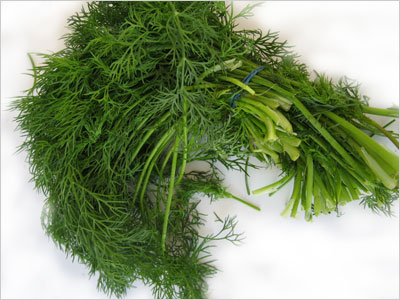|
|
Dill (Anethum Graveolens) Description:
Uses:
In North Eastern Europe and Russia, dill is popular for pickled vegetables, which are there produced in great variety, either by pickling in vinegar or by lactic fermentation. Fresh dill sprigs are mandatory in most recipes of that kind. In these regions with long, cold winters, preserved vegetables are an important source of vitamins and fresh flavour for the otherwise dull winter diet. Dill is also one of the few herbs used in the cooking of the Baltic states, where chopped dill is a frequent decoration on various foods (e.g., boiled potatoes), similar to the use of parsley and chives in other European countries.
Fresh dill leaves are used as an aromatic garnish on fish and shellfish, cottage and cream cheese, and with tomato juice beverages. In the cuisine of the Middle East, dill is used to season meats and vegetables, such as lamb and spinach. German cuisine relies on this herb for garnishing its potato soup and the Greek well known ‘magiritsa soup’ served during Eastern requires dill as a key ingredient. Dill leaves must be used fresh, as they lose their flavor rapidly if dried; even freeze-dried dill leaves have very little flavor.
It is worth noting that fresh dill is much more aromatic than the dried ones and is often much preferred in its fresh state in its various uses.
Medicinal value:
Dill is reputed to have a calming effect on the digestive tract. Oil of Dill is used in mixtures, or administered in doses of 5 drops on sugar, but its most common use is in the preparation of Dill Water, which is a common domestic remedy for the flatulence of infants, and is a useful vehicle for children's medicine generally. It was once given to crying babies, thus deriving its name from the Old Norse, dilla meaning "to lull." Dill is also reputed to cure hiccups, stomach aches, insomnia, and bad breath.
Production and Packaging:
The main (commercial) harvest period for Cyprus fresh dill runs from November to early May. It is usually harvested in bunches of 180 grms washed and pre-cooled before packing. Produce is packed either loose or in liner bags in cartons boxes unless demanded otherwise by the customer and shipped to destination markets normally within 24hrs from harvest. |
|

 Dill (Anethum graveolens) is an annual herb of the parsley family and is related to Anise, Caraway, Coriander, Cumin, and Fennel. The botanical genus name Anethum derives from Greek aneson [ἄíçóïí] or aneton [ἄíçôïí], which also gave rise to the name of anise; the species name graveolens means “strongly smelling” (Latin gravis “grave, heavy” and olens “smelling” from the verb olere). It has long been cultivated as a herb throughout Europe and north Africa as well as in its native Asia and traces of the herb have been found in Roman ruins in Great Britain.
Dill (Anethum graveolens) is an annual herb of the parsley family and is related to Anise, Caraway, Coriander, Cumin, and Fennel. The botanical genus name Anethum derives from Greek aneson [ἄíçóïí] or aneton [ἄíçôïí], which also gave rise to the name of anise; the species name graveolens means “strongly smelling” (Latin gravis “grave, heavy” and olens “smelling” from the verb olere). It has long been cultivated as a herb throughout Europe and north Africa as well as in its native Asia and traces of the herb have been found in Roman ruins in Great Britain.